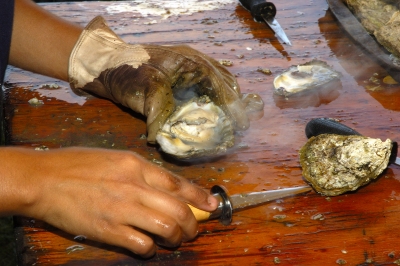
The seafood industry has been a long tradition in So. Md. However, Fourth and fifth generation Watermen from St. George Island told SoMd.com that they expect to be the last generation of watermen due to the death of the local waterways which they attribute to pollution. Photo: David Noss.
Oyster Environmental Impact Study (EIS) Moves Forward, Expected May/June 2007
NORFOLK, Va. - The study evaluating various alternatives to significantly increase the population of oysters throughout the Chesapeake Bay continues to move forward with the release of the DRAFT Oyster Environmental Impact Statement (EIS) report targeted for May/June 2007, according to the Executive Committee for the Oyster EIS which met in December. Once the draft report is released, the public will have an opportunity to provide input. A timeframe for release of the Final EIS will be determined following the completion and review of the public input process.
The EIS Executive Committee is comprised of Maryland Department of Natural Resources Secretary C. Ronald Franks; Virginia Secretary of Natural Resources L. Preston Bryant, Jr.; and United States Army Corps of Engineers Norfolk District Commander, Colonel Dionysios Anninos. The cooperating agencies consist of the Environmental Protection Agency, U.S. Fish and Wildlife Service and National Oceanic and Atmospheric Administration (NOAA). The Potomac River Fisheries Commission (PRFC) and the Atlantic States Marine Fisheries Commission (ASMFC) are also partners in this effort.
The specific goal of the EIS, initiated in Jan. 2004, is to identify a preferred alternative(s) for establishing an oyster population in the Chesapeake Bay that reaches levels comparable to the levels during the period 1920 - 1970. The objective is to restore the ecological role of oysters in the Bay as well as the economic benefits of commercial oyster fishery. Alternatives under consideration include restoration of the native oyster and/or the introduction of an ecologically compatible non-native oyster.
“As a partnership, we must seek a means to create a sustainable solution that is multi-faceted, science-driven, actionable and balanced in restoring the oyster population in the Chesapeake Bay and its tributaries,” states Col. Anninos. “We must allow the EIS to drive the future direction of our oyster population recovery efforts and have a consistent strategy across all the partner organizations to achieve our goals. We will take a systems approach to ensure we understand the second and third order impacts of all the possible alternatives being examined, using agreed-upon evaluation criteria.”
“The continued collaboration among the project partners and scientific community is critical to the completion of this effort and the development of a strategy to significantly increase the Bay’s oyster population level,” said Secretary Franks. “We remain committed to having this study be guided by science and the unfettered and objective input of our partners and the public prior to a final decision.”
The Executive Committee anticipates that some of the more than 40 research studies initiated since the EIS began will still be in progress at the time of the draft report’s release. The influence those studies may have on evaluating the risk and uncertainty associated with pursuing a particular course of action will be identified at the time of the draft report’s release, along with projected timelines for their completion. This research, funded primarily by NOAA, is focused towards further evaluating the recommendations of the National Research Council and Chesapeake Bay Program’s Scientific and Technical Advisory Committee.
A comprehensive peer review process will be performed for each research project. The Executive Committee has charged peer reviewers with evaluating the completeness of each research project within the EIS. In addition to Federal peer review requirements, an independent Oyster Advisory Panel was established to review the sufficiency of the science supporting the draft EIS prior to public release. The panel is comprised of seven-members representing a broad range of non-partisan, scientific expertise and philosophies about marine resources. The Panel’s review may result in recommendations for additional research, with timelines to better clarify the level of risk and uncertainty associated with each alternative under consideration.
“Given the importance of this venture and the significant resources committed to date, it is critical that we present a draft to the public in a timely fashion that highlights what we have learned so far,” said Secretary Bryant. “This draft review is important, as it will allow us to better determine which elements of remaining research to be done are critical for the completion of the EIS. Therefore, we will closely evaluate the recommendations of the independent Oyster Advisory Panel as well as other comments received from our federal partners and the public at large before moving forward with the completion of the final EIS.”
The Executive Committee also reviewed a series of milestones achieved in 2006 toward the completion of the overall oyster study. These included:
* Finalization, approval and implementation of a peer review plan that complies with new federal peer review requirements;
* Incorporation of a peer-reviewed larvae transport model into the demographic model which will provide population projections for the various native oyster restoration strategies and potential non-native introduction strategies;
* Continued strong collaboration with partners and stakeholders. In 2006, 53 working group and outreach meetings were held;
* Continued development of a framework to assess the feasibility and risks associated with each of the EIS’s alternatives relating to native and nonnative oysters. .
For additional information, on the progress of the EIS, available scientific findings and upcoming meetings go to the EIS website at http://www.dnr.state.md.us/dnrnews/infocus/oysters.asp .
Source: Md. Dept. of Natural Resources


